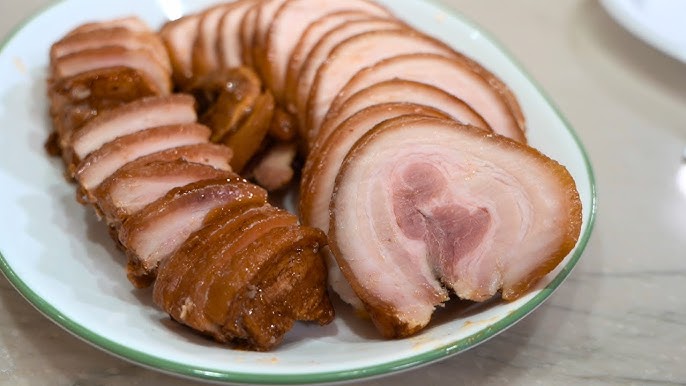Chashu Pork Recipe: If you’re a ramen fan, you’ve likely already fallen in love with those tender, flavorful slices of pork that rest delicately on top of your steaming bowl. That melt-in-your-mouth meat? That’s Chashu Pork, and today, we’re diving deep into how to make it yourself, right at home. No more hunting down ramen shops or pre-packaged versions.
This guide will walk you through everything—ingredients, tools, techniques, and even how to serve it like a pro. Whether you’re making ramen from scratch or just want a rich pork topping for rice, this is the recipe you’ll come back to again and again.
What is Chashu Pork?
Chashu (チャーシュー) is a Japanese braised pork belly dish often used as a ramen topping. It’s savory, slightly sweet, and unbelievably tender thanks to hours of slow cooking. The name “chashu” comes from the Chinese “char siu,” a similarly pork-based dish. However, don’t get these two confused.
While Chinese char siu is roasted and typically glazed with a red, sticky sauce, Japanese chashu is braised slowly in a soy-based broth made with sake, mirin, sugar, and aromatics like garlic and ginger. The result is a more savory, umami-rich profile that melts on your tongue. Its rolled, spiral shape isn’t just for aesthetics—it helps the pork cook evenly and stay juicy.
Why You’ll Love This Recipe
There’s so much to love about homemade Chashu Pork:
- Incredible flavor: Every bite is packed with umami, sweetness, and subtle hints of garlic and ginger.
- Melt-in-your-mouth texture: Thanks to long, slow cooking, the pork becomes soft and succulent.
- Versatile use: Use it in ramen, bao buns, or over rice—this pork works in a variety of dishes.
- Make-ahead friendly: Chashu can be made in advance and keeps well in the fridge or freezer.
- Customizable: Want it more garlicky? Spicier? Sweeter? You’re in control.
List of Ingredients You’ll Need
Here’s everything you’ll need to make authentic Chashu Pork:
Main Ingredients:
- Pork belly (boneless, skin-on or skinless): 2 to 2.5 pounds
- Soy sauce: ½ cup (for umami and saltiness)
- Sake: ½ cup (adds complexity and depth)
- Mirin: ½ cup (adds sweetness and a bit of acidity)
- Sugar: ¼ cup (balances the saltiness)
- Garlic cloves: 5-6, smashed
- Ginger: 1 thumb-sized piece, sliced
- Green onions (scallions): 3-4, cut into large pieces
- Water: Enough to cover the pork
Optional Add-Ons:
- Star anise: For a subtle licorice flavor
- Dried chili or togarashi: If you want a bit of heat
- Miso paste: For a deeper fermented flavor twist
These ingredients are pretty easy to find in Asian grocery stores or even the international section of larger supermarkets. Don’t skip the sake and mirin—they’re key to getting that authentic taste.
Tools and Equipment You’ll Need
Making Chashu isn’t overly complicated, but having the right tools can make a big difference:
- Large Dutch oven or pot: For braising
- Tongs: To handle hot meat
- Kitchen twine: For rolling and securing the pork
- Sharp knife: For slicing thin, even rounds
- Cutting board: Preferably one you reserve for meat
- Storage container: Airtight, for refrigerating or freezing leftovers
If you’re using a slow cooker or pressure cooker, you’ll need those instead of a stovetop pot. Just make sure your cooking vessel has a tight-fitting lid to retain moisture.
How to Choose the Right Cut of Pork
When it comes to chashu, pork belly is king. It has the perfect fat-to-meat ratio that renders down beautifully during the slow-cooking process. You can use skin-on pork belly if you want extra texture, or go skinless for a softer result.
Can You Use Pork Shoulder?
Yes, but it’s not quite the same. Pork shoulder (also known as pork butt or Boston butt) is leaner and better suited for pulled pork or kakuni-style dishes. If you’re in a pinch, it works, but the results won’t be as juicy or tender.
Preparation: Getting the Pork Belly Ready
The secret to that classic Chashu look is in how you roll and tie the pork. Here’s how to do it:
- Trim the pork belly if there are uneven edges or too much silver skin.
- Roll the pork belly lengthwise into a tight log, like a jelly roll.
- Use kitchen twine to tie it in 1-inch intervals. This helps the pork hold its shape during cooking and creates that beautiful spiral when sliced.
- Let the tied pork belly sit at room temperature for 15–30 minutes before searing.
This step is crucial. Not only does it help the meat cook evenly, but it also gives it that classic round shape that looks so good in a bowl of ramen.
Making the Perfect Marinade
Let’s talk flavor. The marinade is what makes chashu shine.
Core Ingredients:
- Soy sauce
- Sake
- Mirin
- Sugar
- Garlic
- Ginger
- Scallions
Instructions:
- In a bowl, combine the soy sauce, sake, mirin, and sugar.
- Stir until the sugar fully dissolves.
- Add smashed garlic, sliced ginger, and scallions.
- If you’re using extras like star anise or miso, add them now.
This mix will serve both as your braising liquid and your flavor infusion. The aromatics infuse into the pork slowly over hours, creating a depth of flavor you simply can’t rush.
Step-by-Step Guide: How to Cook Chashu Pork
Alright, now that everything’s prepped, let’s get into the actual cooking process. Take your time with each step—this isn’t a rush job. The magic of chashu is in the slow, flavorful braise.
Step 1: Searing the Pork Belly
First things first—sear the rolled and tied pork belly. This is key for locking in flavor and developing a deep, rich color.
- Heat a bit of oil in a large Dutch oven or deep pot over medium-high heat.
- Carefully add the pork belly and sear on all sides until golden brown. This should take about 2–3 minutes per side.
- Once evenly seared, remove the pork temporarily and set it aside.
Why sear? You’re building flavor here. Those caramelized bits on the surface (called the Maillard reaction) will mix with the marinade to create an incredibly savory depth.
Step 2: Simmering in Marinade
Now it’s time to add your prepared marinade.
- Pour the soy sauce, sake, mirin, sugar, and aromatics into the same pot.
- Place the seared pork belly back in.
- Add just enough water to cover the pork fully.
- Bring everything to a gentle simmer, not a boil. Boiling will toughen the meat.
Let it simmer with the lid on for the first hour. You want to maintain a low and steady heat, allowing the pork to soak up all those rich, aromatic flavors.
Step 3: Slow Cooking for Maximum Flavor
Continue cooking the pork for about 2.5 to 3 hours, checking every 30 minutes.
- Turn the pork occasionally so it cooks evenly on all sides.
- If too much liquid evaporates, add a splash of water.
- Taste the sauce midway. If it’s too salty, dilute it. If it’s too sweet, add a touch more soy.
By the end of the 3-hour mark, the pork should be fork-tender and aromatic. You’ll notice the marinade has reduced to a thick, almost syrupy glaze—that’s pure flavor gold.
Step 4: Resting and Chilling the Chashu
Once cooked, remove the pork and let it cool to room temperature. This is crucial for slicing.
- Transfer the pork (still tied) to a container and pour a few spoonfuls of the reduced sauce over it.
- Cover and refrigerate for at least 4 hours or overnight.
This resting time allows the pork to firm up, making it easier to slice into thin, even rounds. It also deepens the flavor as the meat absorbs more of the braising liquid.
How Long Should You Cook Chashu Pork?
Time is flavor when it comes to chashu. While you can technically cook it in under two hours, the sweet spot is around 3 hours.
Stovetop Method:
- Low simmer for 2.5 to 3 hours.
- Ideal for flavor and texture but requires more babysitting.
Oven Method:
- Set oven to 275°F (135°C).
- Braise in a covered Dutch oven for 3 to 3.5 hours.
This method gives consistent heat and less evaporation—ideal if you don’t want to hover over the stove.
Pressure Cooker or Instant Pot:
- Cook on high pressure for 50 minutes.
- Let pressure release naturally for 15 minutes.
- Finish by simmering the sauce until it thickens.
While faster, this method sacrifices a bit of the depth you get from slow braising. Still, it’s a solid shortcut when you’re tight on time.
Cooling and Slicing the Pork
This might be the most satisfying part—revealing that beautiful spiral and perfect tenderness.
Why Chill Before Slicing?
Cutting warm chashu is a mess. It falls apart and you lose that Instagram-worthy swirl. Chilling firms up the fat, making it easy to get clean, even slices.
Slicing Tips:
- Use a sharp chef’s knife or slicing knife.
- Slice to about ¼ inch thick for ramen, slightly thicker for rice bowls.
- Warm slightly before serving by dipping slices in hot ramen broth or reheating gently in sauce.
The presentation alone is worth the extra effort. Once sliced, you’ll see that spiral of fat and meat that makes chashu so iconic.
Serving Suggestions
You’ve done all the work—now it’s time to enjoy that glorious pork belly.
1. Ramen Topping
The classic. Lay a few slices on top of a steamy bowl of ramen, drizzle with a bit of leftover sauce, and garnish with scallions, sesame seeds, or a soft-boiled egg.
2. Chashu Don (Rice Bowl)
Serve sliced chashu over steamed white rice, add some pickled ginger, and drizzle with extra sauce. Quick, filling, and ridiculously tasty.
3. Chashu Bao Buns
Stuff soft steamed bao buns with sliced chashu, pickled veggies, and hoisin or spicy mayo. It’s street food meets comfort food in the best way.
Storing and Reheating Leftovers
Chashu keeps surprisingly well, which makes it great for meal prep.
Storage Tips:
- Refrigerator: Store sliced or whole chashu in an airtight container for up to 5 days.
- Freezer: Wrap tightly in plastic wrap and store in a zip-top bag for up to 2 months. Freeze it whole for better texture.
Reheating Tips:
- Slice and reheat gently in simmering broth or sauce.
- Microwave on low power, covered with a damp paper towel.
- Avoid high heat—it will dry out the meat.
Pro Tips for the Best Homemade Chashu
Want to level up your chashu game? Here’s how:
- Don’t rush the sear. That’s where your depth of flavor starts.
- Use quality pork. Fatty, well-marbled pork belly makes all the difference.
- Chill overnight. It slices better and tastes richer the next day.
- Reduce the sauce. After cooking, simmer the leftover liquid into a glaze—amazing over rice or as a ramen drizzle.
- Add soft-boiled eggs to the marinade. Instant ajitsuke tamago (ramen eggs)!
Common Variations of Chashu
There’s more than one way to chashu. Let’s explore a few popular tweaks.
Sous Vide Chashu
- Roll, tie, and marinate the pork.
- Seal in a vacuum bag and cook at 170°F (76°C) for 10–12 hours.
- Sear after cooking for that classic crust.
Result? Ultra-consistent texture and flavor.
Miso or Spicy Chashu
- Add miso paste or Korean gochujang to the marinade.
- It adds a deeper umami punch or a spicy kick.
Perfect for those who like a twist on the traditional.
Nutrition Information
Here’s a rough estimate per serving (based on 8 servings from 2.5 lbs pork belly):
| Nutrient | Amount |
|---|---|
| Calories | 410 kcal |
| Protein | 22g |
| Fat | 35g |
| Carbohydrates | 6g |
| Sugar | 4g |
| Sodium | High |
Note: These values vary based on exact ingredients and serving size.
FAQs about Chashu Pork Recipe
1. Can I make Chashu ahead of time?
Absolutely. In fact, it tastes better the next day. Let it chill overnight for easier slicing and deeper flavor.
2. Is Chashu spicy?
Not traditionally. But you can add heat with chili flakes, togarashi, or a splash of chili oil.
3. Can I freeze Chashu?
Yes. Wrap it tightly in plastic wrap, then store in an airtight container or freezer bag. It’ll keep for up to 2 months.
4. What’s the difference between Chashu and Kakuni?
Chashu is rolled and sliced thin, often used in ramen. Kakuni is chunkier, cubed pork belly usually braised in a slightly sweeter sauce.
5. Do I need sake and mirin, or can I substitute?
You can substitute with dry sherry (for sake) and a mix of rice vinegar + sugar (for mirin), but the flavor won’t be quite the same.
Conclusion
Making Chashu Pork at home might sound like a project, but once you taste the results—you’ll never go back to store-bought. The tender, juicy pork, infused with that irresistible blend of soy, sake, and sweetness, is the perfect upgrade to your ramen nights, rice bowls, or even sandwich fillings. With a little time and patience, you’ll master the art of chashu and wonder why you didn’t try it sooner.
So roll up your sleeves, grab that pork belly, and let’s get braising!



